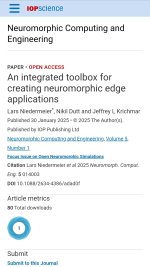Another positive paper from 2024 I hadn't seen before but maybe posted somewhere.
Interesting small satellite project group appearing to be working with NASA and also have another related paper which I'm pretty has been discussed before...Brainsat.
This paper:
HERE
Who is the Space Generation Advisory Council?
OUR VISION is to employ the creativity and vigour of youth in advancing humanity through the peaceful uses of space. We are the VOICE of the largest network of students, young professionals

spacegeneration.org
We are the VOICE of the largest network of students, young professionals and alumni in the space industry.
29,000+
Members Globally
165+
Countries Worldwide
30+
SGAC Events Annually
11
Active Project Groups
Spiking Neural Network Design for on-board detection of methane emissions through Neuromorphic Computing
Andrew Karima∗
, Amel AlKholeifya
, Jimin Choia
, Jatin Dhalla
, Tan Hudaa
, Arnav Ranjekara
,
Yassine Yousfia
, Daniel Wischerta
a Space Generation Advisory Council, Small Satellite Project Group
* Corresponding author (
andrew.karim@spacegeneration.org andrew.karim@spacegeneration.org andrew.karim@spacegeneration.org)
Abstract
Small satellite constellations have shown tremendous success for Earth observation missions and can mimic the
performance of large satellite platforms while being cheaper and faster to deploy.
Detecting fugitive methane emissions
from ageing oil and gas infrastructures is an important use-case, as it helps facility operators to locate and mitigate these
leaks, ultimately addressing the global climate crisis. For such applications, it is crucial for the data to be transmitted
to the end-user in a timely manner for appropriate actions to take place. Edge Artificial Intelligence (AI) can address
this issue by pre-processing the data on-board the spacecraft, dramatically reducing the amount of data to be sent to
the ground and thus improving response times and bandwidth. As small satellites are greatly constrained by a low size,
weight and power (SWaP), their ability to process AI algorithms with fewer computational resources is essential.
AI applications often depend on real time data processing and analysis, yet most modern computers are inefficient in
these tasks. Neuromorphic Computing’s (NC) parallel and distributed architecture helps perform complex calculations
faster while using less power, enabling more efficient in-orbit data processing and onboard adaptive learning. This paper evaluates the potential of a novel 6U CubeSat neuromorphic on-board computer, applied to a case study for point-source methane emissions monitoring. It involves the design of a Spiking Neural Network (SNN) tailored for small satellite platforms.
The necessary processing steps for detection of point-source methane emissions using hyperspectral imagery are presented, and the potential of edge computing is discussed. A full processing pipeline enabling real-time monitoring
is proposed, which involved an SNN for segmentation of methane plumes. The architectural specifications necessary for
neuromorphic computing in the resource-constrained satellite environment are outlined. NC principles are incorporated
into the SNN architecture design, leveraging event-driven computation to improve energy efficiency and computational throughput. The processor’s performance is compared with traditional computing approaches.
Finally, a plan to train the model using an annotated dataset from the AVIRIS-NG hyperspectral instrument is presented, although training and validation are left for future work.
By embracing neuromorphic computing, an innovative approach inspired by the brain, satellites can achieve unparalleled efficiency and accuracy. The SNN model presented contributes to the scarce body of research on edge AI for greenhouse gas monitoring, providing a step forward towards real-time Earth observation.
Excerpt:
The designed OBP includes two PC104 modules, connected through a mezzanine connector. It integrates both CPU and FPGA capabilities and can cater for on board computer functions, payload data processing and down link management.
The OBP is equipped with the Akida
1000 neuromorphic processor, selected for its design maturity, real-time processing capabilities and flight heritage.
The chip is tailored for event-based processing, featuring 80 Neuromorphic Processing Units (NPUs) with 100 KB
of SRAM each, supporting up to 1.2 million virtual neurons and 10 billion virtual synapses with up to 8-bit pre-
cision,
ideal for inference-heavy tasks. An FPGA provides glue logic to implement necessary data protocols and serve as a soft CPU for OBC functions.
Additionally, a 12GB flight-proven Micron Solid State Device (SSD) is included to provide non-volatile on-board memory. This sub-system is constrained to a 0.5 U volume and is estimated to consume a low power of less than 4 W.
The processor’s software architecture was designed to minimize resource consumption. It is equipped with Real-
Time Executive for Multiprocessor Systems (RTEMS) as its Real Time Operating System (RTOS),
on top of which
NASA’s core Flight System (cFS) is used. cFS provides a flight proven product on which OBP functions are built using open-source applications. For more information about the BrainSat architecture, refer to our co-published pro-
ceeding [12].
6. Conclusion
In this paper, we have proposed a hyperspectral imagery on-board data processing pipeline that can pave the way for fully autonomous methane detection systems using small satellites. After converting the measured raw hyperspectral data to measured at-sensor radiance, a matched filter algorithm is applied, which implies comparing the methane enhancement above background with a simulated target absorption spectrum. This result is then
fed to a Spiking Neural Network, inspired by the Hyper-STARCOP architecture but tailored to neuromorphic computers trained using a recent hybrid co-training approach.
This allows to polish the methane plume masks by reducing the false positives, which can be downlinked to mission operators for further processing. The principal bottleneck remains using a radiative transfer model on-board the platform to simulate the methane absorption spectrum according to observation parameters, which is not evaluated in this work.
The approach presented reduces the steep bandwidth requirements for hyperspectral imagers by reducing the
size of the downlinked data by a factor of ten. Limited to a maximum power usage of 4 W and a volume of 0.5 U,
the proposed hardware is ideal for CubeSats and enables several other Earth Observation applications, such as onboard cloud detection and image compression or classification.on CARLsim++ (which got implemented on Akida hardware in the researchers’ experiments) just got a lot more exposure thanks to LinkedIn posts by two of its co-authors…

www.linkedin.com




